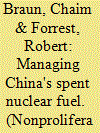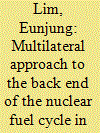| Srl | Item |
| 1 |
ID:
156584


|
|
|
|
|
| Summary/Abstract |
China, as the world leader in constructing new nuclear reactors, has yet to resolve either its short-term spent nuclear fuel (SNF) problems or the challenge of long-term final disposition. While it may be several decades before the fuel disposition question will be resolved, the near-term problem of establishing adequate interim SNF storage is much more acute. The state of nuclear-reactor development in China presents an opportunity to address SNF management issues at an early stage. This article outlines a scenario-based study aiming to inform SNF interim storage policy even while the final disposition solution remains uncertain. We describe a comprehensive model and show results from a crucial subset of issues—the logistics of SNF accumulation, transportation, and storage—and describe simple steps to strengthen the SNF storage system. Finally, we forecast when the current method of SNF disposition could break down and offer recommendations and guidance for further study.
|
|
|
|
|
|
|
|
|
|
|
|
|
|
|
|
| 2 |
ID:
149945


|
|
|
|
|
| Summary/Abstract |
In spite of the nearly unprecedented scale of the Fukushima Daiichi Nuclear Accident which caused countries around the world to review their nuclear power systems and to rethink their nuclear power expansion plans, nuclear power capacity continues to grow, spearheaded by the Asia-Pacific region. The Asia-Pacific has become a major emerging market for nuclear energy industry, which indicates that the management of spent nuclear fuel is likely to be a nuisance for the countries in this region in the coming decades. By reviewing the history of discussions on multilateral approaches to the back end of the nuclear fuel cycle and examining relevant empirical cases, this article aims to explore the feasibility of a multilateral approach to the back end of the nuclear fuel cycle in this region and provide some policy suggestions to enhance nuclear governance in the Asia-Pacific.
|
|
|
|
|
|
|
|
|
|
|
|
|
|
|
|
| 3 |
ID:
088050


|
|
|
|
|
| Publication |
2009.
|
| Summary/Abstract |
The purpose of this article is to explain why the world's nuclear power countries differ from each other with respect to their spent nuclear fuel (SNF) policies. The emergence and evolution of three principal SNF approaches are analyzed: direct disposal, reprocessing and SNF export. Five broad explanatory factors are identified and discussed in relation to the observed differences in policy outcomes: military ambitions and non-proliferation, technological culture, political culture and civil society, geological conditions, and energy policy. SNF policy outcomes can generally be seen to result from a complex interaction between these broad factors, but it is also possible to discern a number of important patterns. To the extent that the five factors may undergo far-reaching changes in the future, the historical experience of how they have shaped SNF policies also give a hint of possible future directions in SNF policymaking around the world.
|
|
|
|
|
|
|
|
|
|
|
|
|
|
|
|
| 4 |
ID:
177412


|
|
|
|
|
| Summary/Abstract |
Irradiated or Spent Nuclear Fuel (SNF, where it could be “used nuclear fuel” if reprocessing facilities are available) is periodically removed from nuclear power reactors and allowed to decay in suitable storage facilities. This paper attempts to calculate the relationships between sizes and costs of wet/dry and onsite/offsite SNF storage. The methodology is (1) to propose cost models based on publicly available data and (2) to estimate cost equations to compare the various storage costs. When the fuel pool nears capacity, the cheapest alternative is to transfer SNF to onsite dry storage. Once a nuclear power plant has been decommissioned, and only the onsite dry storage facility remains, there appears to be little economic reason (from the nuclear power plant owner/operator’s viewpoint) to move the SNF to consolidated facilities because of extra monetary and non-monetary costs. Unless there are explicit national policies and funded programs to manage SNF, there are likely to be legacy sites with stranded SNF. On the other hand, there is a consensus that consolidated facilities (1) would be more safe and secure than dispersed onsite storage locations, (2) would facilitate final disposal, and (3) might reduce the risks perceived by local communities of storing SNF.
|
|
|
|
|
|
|
|
|
|
|
|
|
|
|
|